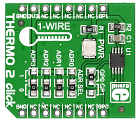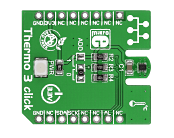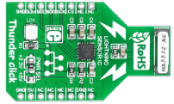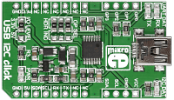Search
Search for "click":
(Click here to search this entire website for "click" with Google.)
 |

|
|
Step Up Click is a fixed frequency DC-DC step-up (boost) regulator, which can be obtained from any low voltage input - such as NiCd, NiMH or one cell Li-Po/Li-Ion batteries. This click features very high efficiency, low noise and anti-ringing voltage output and inrush current limiting with the internal soft-start, as well as true disconnect option for minimized power drain, when in shutdown mode. These features allow this device to be used as the power source for various battery-operated devices, such as microcontrollers, various portable embedded electronic devices, handheld instruments, GPS modules, or various battery-operated USB emergency backup chargers. Very good switching efficiency factor ensures prolonged battery life for any application this device is used in.
Step Up click board™ is supported by a mikroSDK compliant library, which includes functions that simplify software development. This Click board™ comes as a fully tested product, ready to be used on a system equipped with the mikroBUS™ socket.
|
|
|
|
 |

|
|
STEPPER click is a stepper motor driver board in the mikroBUS form factor. It features the A3967SLBT microstepping motor driver, with a built-in translator for easily driving bipolar steper motors in full-, half-, quarter- and eighth-step modes with output drive capability of 30V and about ±500 mA. The package includes a standard B5B-XH-A connector (delivered unsoldered) for easily connecting your stepper motor. The motor can be powered from either the 5V mikroBus line, or from an external power supply (5-30V) using the provided screw terminal connector. The board can communicate with either 3.3V or 5V systems (selection by means of SMD jumper). An LED diode serves as a power indicator. |
|
|
|
 |

|
|
Stretch click is a mikroBUS add-on board with circuitry for measuring stretch forces with conductive rubber cords. The click has screw terminals for connecting 2mm-diameter conductive rubber cord. The resistance of the chord increases when stretched, impacting the voltage available on the AN pin. Stretch click is designed to use either a 3.3V or 5V power supply.
In a "relaxed" state, the resistance is about 130 ohms per centimeter. As you pull on it, the resistance increases (the particles get further apart). As you stretch it out, the resistance increases. So lets say you have a 15cm piece - thats about 2.1 Kohms.
Stretch it to 25cm long and now it is 26/15*2.1K = 3.5 Kohms. You can stretch the rubber about 50-70% longer than the resting length, so a 15cm piece shouldn't be stretched more than 25cm. Once the force is released, the rubber will shrink back, although its not very "fast" and it takes a minute or two to revert to its original length. It's not a true linear sensor, and the resistance may vary from batch to batch, so we consider it a way to measure stretching motion but isn't really precise.
One meter of conductive rubber cord and two alligator clips are included in the package. |
|
|
|
 |

|
|
Thermo 2 click carries DS1825, a programmable resolution digital thermometer IC. It measures temperature within a range from - 10°C to 85°C with +/-0.5°C accuracy. You can specify the resolution of the measurements, from 9 to 12-bit, depending on the application. The board communicates with the target microcontroller through a 1-wire interface. Using the onboard jumper, you can choose between two mikroBUS pins for setting the output. Thermo 2 click also features four Address Select jumpers for setting a unique ID for the sensor (allowing for up to 16 sensors to operate on a single 1-Wire bus). |
|
|
|
 |

|
|
Thermo 3 click carries TMP102, a digital temperature sensor IC with a tiny footprint of only 1.6mm x 1.6mm.. Without requiring calibration, TMP102 is accurate within 0.5°C. Measurement range is between -25°C to 85°C. An integrated 12-bit ADC allows for measurement resolutions down to 0.0625°C. Thermo 3 click communicates with the target board MCU through mikroBUS I2C pins (SCL, SDA), and an additional Alert pint (INT on the default mikroBUS configuration). The board is designed to use a 3.3V power supply only. |
|
|
|
 |

|
|
Thunder click features the AS3935 lightning sensor as well as an MA5532 coil antenna. It detects the presence and proximity of potentially hazardous lightning activity in the vicinity and provides an estimated distance to the center of the storm. It can also provide information on the noise level. Thunder click communicates with the target board microcontroller via SPI and INT lines. An LED indicates the presence of power supply to the board, which can be either 3.3V or 5V. |
|
|
|
 |

|
|
USB I2C click carries an MCP2221 USB-to-UART/I2C converter. The chip supports full-speed USB (12 Mb/s), I2C with up to 400 kHz clock rates and UART baud rates between 300 and 115200. The board communicates with the target MCU through mikroBUS UART (RX, TX) or I2C (SCL, SDA) interfaces. In addition to mikroBUS, the edges of the board are lined with additional GPIO and I2C pins. It can operate on 3.3V or 5V logic levels. |
|
|
|
 |

|
|
USB MUX Click is a compact add-on board with a high-bandwidth switch designed for switching and isolating high-speed USB 2.0 signals in systems with limited USB I/Os. This board features the TS3USB30E, a USB 2.0 1:2 multiplexer/demultiplexer switch with a single enable from Texas Instruments. It offers a wide bandwidth of 900MHz that allows signals to pass with minimum edge and phase distortion. The USB MUX Click is designed to multiplex differential outputs from a USB host device to one of two corresponding outputs or two different hosts to one corresponding output. This Click board™ makes the perfect solution for the development of multi-purpose signal-switching devices, portable electronics, and other applications with limited USB I/Os.
USB MUX Click is supported by a mikroSDK compliant library, which includes functions that simplify software development. This Click board™ comes as a fully tested product, ready to be used on a system equipped with the mikroBUS™ socket.
|
|
|
|
 |

|
|
USB SPI Click is an accessory board in the mikroBUS form factor. It is a compact and easy solution for adding SPI serial communication via USB. It features the MCP2210 USB-to-SPI protocol converter with GPIO as well as USB MINI B connector. USB SPI click communicates with target board via SPI interface as a master device. An SMD jumper is available for selecting whether board will be operating on a 3.3V or 5V power supply. |
|
|
|
 |

|
|
V to HZ click is a device that turns analog voltage into a pulse wave signal of a certain frequency. It has a linear response, so applying a voltage in a range of 0 to 5V on its input, will result in generating the pulse train with frequency linearly proportional to the input voltage. This click features very good linearity, covers a frequency range from 10Hz to 10 kHz and it has a good temperature stability.
These features allow this device to be used in various voltage to frequency applications: it can be used in various applications in instrumentation, industrial, and automation markets. It is well suited for use in AD conversion, long-term integration, linear frequency modulation, voltage-to-frequency conversion and it can be used as the variable clock signal generator. |
|
|
|
 |
|
<< First
< Previous
Next >
|
|

